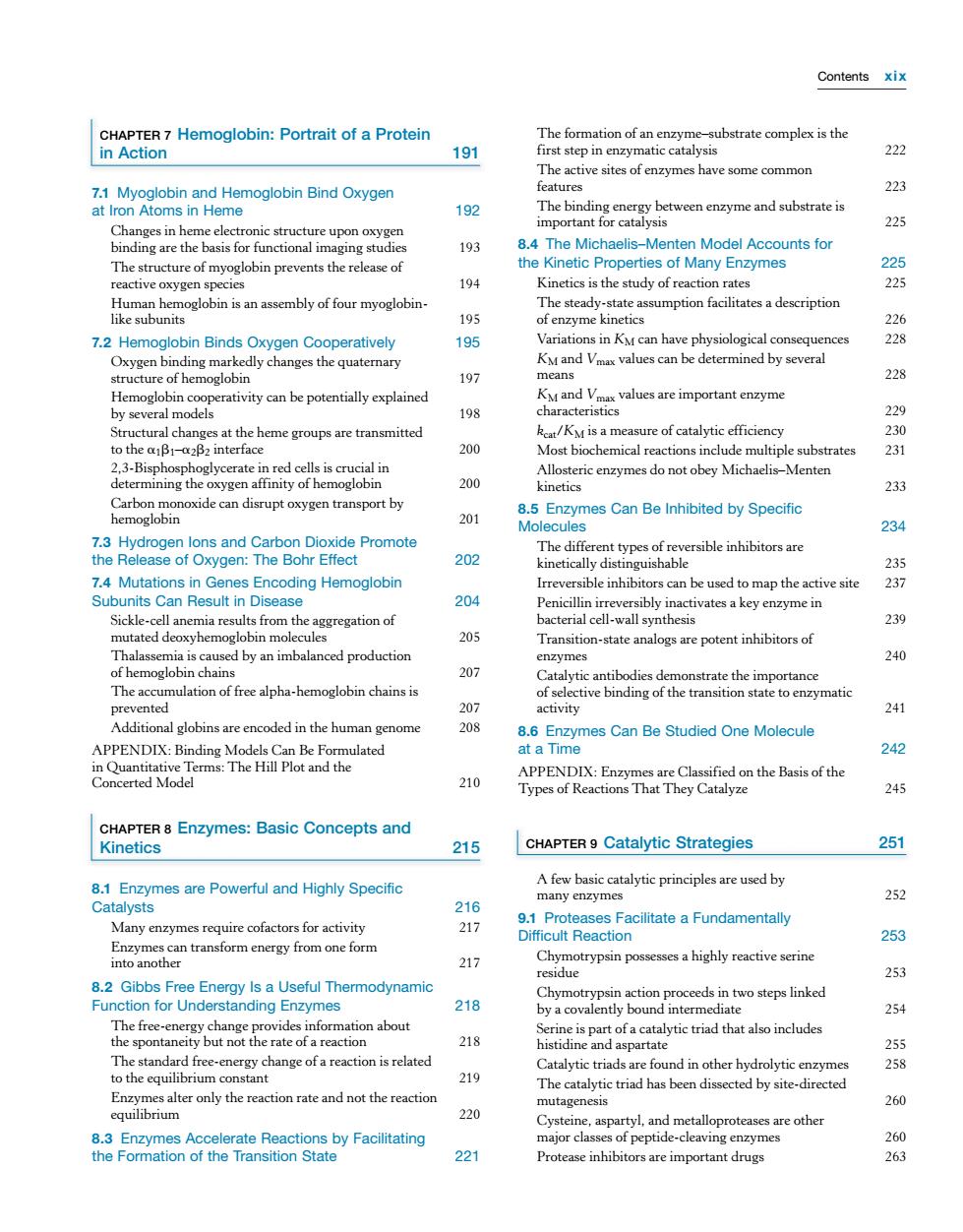正在加载图片...

Contents xix CHAPTER7 Hemoglobin:Portrait of a Protein in Action 191 222 The ac 6heaohnnlemogobnBnd0ygen 223 192 Changes in heme electronic structure upon oxyger 225 binding are the basis for functional imaging studie 193 84 The Michaelis-M ten Model Accounts for the Kinetic Properties of Many Enzymes 225 194 kinetics is the study of reaction rates 225 195 226 7.2 Hemoglobin Binds Oxygen Cooperatively 195 s in K nce 228 dly changes the quaternary KM and V 197 means 228 Hemoglobin co values are important enzyme by severa /KM 230 e groups are transt 200 Most biochemical reactions incude multiple substrates 231 200 233 Carbon m n dis port by emoglobin 201 Enzymes Can Be Inhibited by Specific 234 e of Oxygen: 202 enes Encoding Hemoglobin Irreversible inhibitors can be used to map the active site 237 204 205 Transition-state re potent inhibitors of byn imbalanced productio enzymes 240 207 The mulation of free alpha-hemoglobin chains is 20 activity Can Bedd nM 242 210 the Bais of the P 245 215 CHAPTER9 Catalytic Strategies 251 8.1 Enzymes are Powerful and Highly Specific A few basic catalytic principles are used by many enzymes 252 Catalysts Many enzymes require cofactors for activity 217 253 sea highly reactive serine 253 8 2 Gibhs Free En rmodynamic 218 Chymotrypsin action proceeds in two steps linked by a covalently 254 The fre rate of a reaction hange of a reaction is related 255 to theq Catalytic triads are found in other hydrolytic enzymes 258 219 artyl.and metalloproteases are othe erate Reactions by Facilitating major classes of peptide-cleaving enzymes 22 Protease inhibitors are important drugsContents xix CHAPTER 7 Hemoglobin: Portrait of a Protein in Action 191 7.1 Myoglobin and Hemoglobin Bind Oxygen at Iron Atoms in Heme 192 Changes in heme electronic structure upon oxygen binding are the basis for functional imaging studies 193 The structure of myoglobin prevents the release of reactive oxygen species 194 Human hemoglobin is an assembly of four myoglobinlike subunits 195 7.2 Hemoglobin Binds Oxygen Cooperatively 195 Oxygen binding markedly changes the quaternary structure of hemoglobin 197 Hemoglobin cooperativity can be potentially explained by several models 198 Structural changes at the heme groups are transmitted to the a1b1–a2b2 interface 200 2,3-Bisphosphoglycerate in red cells is crucial in determining the oxygen affinity of hemoglobin 200 Carbon monoxide can disrupt oxygen transport by hemoglobin 201 7.3 Hydrogen Ions and Carbon Dioxide Promote the Release of Oxygen: The Bohr Effect 202 7.4 Mutations in Genes Encoding Hemoglobin Subunits Can Result in Disease 204 Sickle-cell anemia results from the aggregation of mutated deoxyhemoglobin molecules 205 Thalassemia is caused by an imbalanced production of hemoglobin chains 207 The accumulation of free alpha-hemoglobin chains is prevented 207 Additional globins are encoded in the human genome 208 APPENDIX: Binding Models Can Be Formulated in Quantitative Terms: The Hill Plot and the Concerted Model 210 CHAPTER 8 Enzymes: Basic Concepts and Kinetics 215 8.1 Enzymes are Powerful and Highly Specific Catalysts 216 Many enzymes require cofactors for activity 217 Enzymes can transform energy from one form into another 217 8.2 Gibbs Free Energy Is a Useful Thermodynamic Function for Understanding Enzymes 218 The free-energy change provides information about the spontaneity but not the rate of a reaction 218 The standard free-energy change of a reaction is related to the equilibrium constant 219 Enzymes alter only the reaction rate and not the reaction equilibrium 220 8.3 Enzymes Accelerate Reactions by Facilitating the Formation of the Transition State 221 The formation of an enzyme–substrate complex is the first step in enzymatic catalysis 222 The active sites of enzymes have some common features 223 The binding energy between enzyme and substrate is important for catalysis 225 8.4 The Michaelis–Menten Model Accounts for the Kinetic Properties of Many Enzymes 225 Kinetics is the study of reaction rates 225 The steady-state assumption facilitates a description of enzyme kinetics 226 Variations in KM can have physiological consequences 228 KM and Vmax values can be determined by several means 228 KM and Vmax values are important enzyme characteristics 229 kcat/KM is a measure of catalytic efficiency 230 Most biochemical reactions include multiple substrates 231 Allosteric enzymes do not obey Michaelis–Menten kinetics 233 8.5 Enzymes Can Be Inhibited by Specific Molecules 234 The different types of reversible inhibitors are kinetically distinguishable 235 Irreversible inhibitors can be used to map the active site 237 Penicillin irreversibly inactivates a key enzyme in bacterial cell-wall synthesis 239 Transition-state analogs are potent inhibitors of enzymes 240 Catalytic antibodies demonstrate the importance of selective binding of the transition state to enzymatic activity 241 8.6 Enzymes Can Be Studied One Molecule at a Time 242 APPENDIX: Enzymes are Classified on the Basis of the Types of Reactions That They Catalyze 245 CHAPTER 9 Catalytic Strategies 251 A few basic catalytic principles are used by many enzymes 252 9.1 Proteases Facilitate a Fundamentally Difficult Reaction 253 Chymotrypsin possesses a highly reactive serine residue 253 Chymotrypsin action proceeds in two steps linked by a covalently bound intermediate 254 Serine is part of a catalytic triad that also includes histidine and aspartate 255 Catalytic triads are found in other hydrolytic enzymes 258 The catalytic triad has been dissected by site-directed mutagenesis 260 Cysteine, aspartyl, and metalloproteases are other major classes of peptide-cleaving enzymes 260 Protease inhibitors are important drugs 263 CHAPTER 7 Hemoglobin: Portrait of a Protein in Action 191 CHAPTER 8 Enzymes: Basic Concepts and Kinetics 215 CHAPTER 9 Catalytic Strategies 251